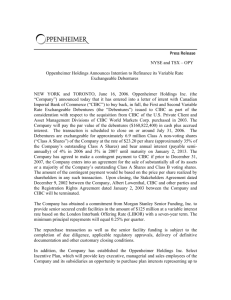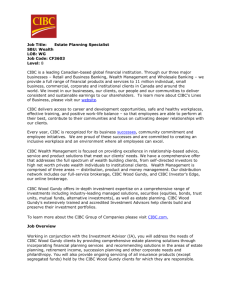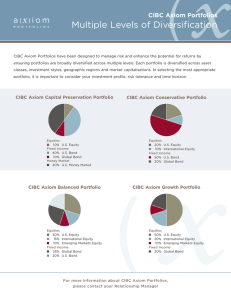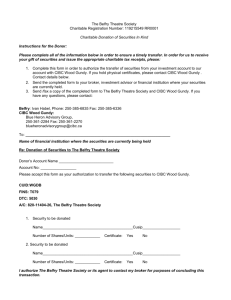Creating cash reserves
advertisement
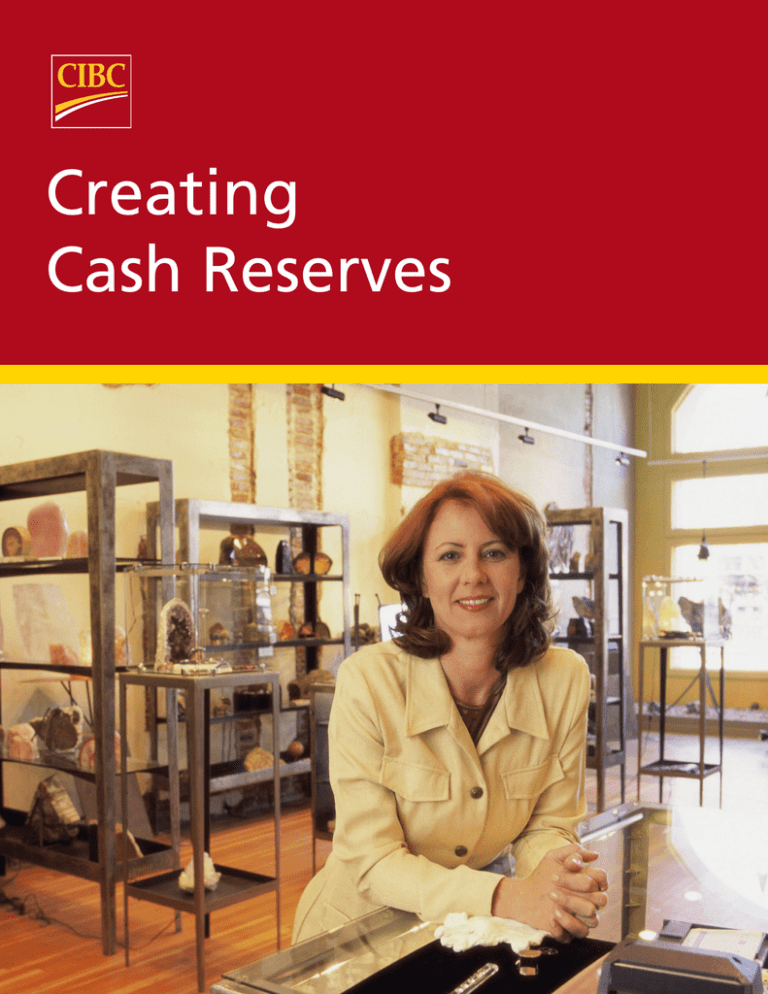
Creating Cash Reserves Creating cash reserves Running a successful business is a juggling act between cash coming in, and cash going out. Businesses don’t generally fail from lack of sales, but rather because they run out of cash. Businesses that have cash reserves are therefore better able to handle short-term issues such as a reduction in sales than those without. Cash in the bank acts as a buffer and can help you better weather the ups and downs you may encounter in running your business. Reserve cash buys you more time if things go wrong, and it allows you to experiment and test new ideas without needing immediate revenues to cover your costs. Cash gives you three luxuries: 1. Cash enables investment Cash gives you the flexibility to invest in what’s important for your business. You can try out new ideas, build new products, spend time sourcing new customers or take advantage of sales on equipment, inventory or other inputs that allow you to generate even more cash down the road. 2. Cash reduces stress Spare cash can give you greater peace of mind and lower your stress levels. The less worried you are about your business finances, the more attention you can put towards ensuring your staff and customers are satisfied, and may make you a happier person to be around. Lenders and business partners see money reserves and a strong cash flow as good performance indicators. 3. Cash helps survival A cash reserve enables you to overcome short-term fluctuations in cash, resulting from: • • • • • • Slow paying customers Brief interruptions in business Seasonal downturns Time needed to develop new products or markets Competitor action such as undercutting your prices Threats from new competitors entering your market Using this resource Completing this interactive PDF will help you to assess possible cost savings in your business. Complete all the sections, estimate your savings, and then turn to the end, where your overall savings will be calculated for you. 2. CIBC Creating cash reserves Contents Creating cash reserves 2 Step one: Focus on your goods and services 4 Step two: Chase debts 6 Step three: Check communication and technology costs 7 Step four: Trim your costs 9 Step five: Looking internally 10 Step six: Evaluate Your Business Borrowing 11 A checklist of cash generating ideas 12 Finally: Crunch the numbers 14 Appendix: CIBC Investment Solutions 16 3. CIBC Creating cash reserves Step one: Focus on your goods and services Increase your prices Small businesses may not always charge what things are worth. Evaluate regularly whether prices can be increased by checking your costs and what competitors are charging. If you don’t keep up with inflation, you’re going backwards, so as a general rule­ of-thumb, customers should be paying more each year, unless your input costs are also falling. A small increase in price without any fall in sales, or increase in overheads, adds up over time. Identify services you provide or products you sell that are price insensitive and increase the price by a small amount. List below any product prices you could increase without a negative customer reaction: Product 1. Price increase $ # of items sold 2. $ $ 0 3. $ $ 0 4. $ $ 0 5. $ $ 0 6. $ $ 0 7. $ $ 0 8. $ $ 0 9. $ $ 0 10. $ $ 0 TOTAL: 4. CIBC Creating cash reserves Mthly sales increase $ 0 $0 Decrease stock levels Reducing stock levels can transfer cash directly to your bottom line. You might be able to reduce the stock and raw materials you hold by making better use of online ordering and more efficient warehousing software so that you stock only what you need for the immediate future. Have a sale! By holding a stock review every few months you may be able to eliminate any redundant products and slow sellers. You may also be able to buy stock from suppliers just a few days before you need it. The money saved can then go straight into the bank. You can sometimes receive large discounts by buying stock or materials in bulk, but always weigh this against the fact that this cash is then not available for anything else. This is especially critical when times are tough and you need cash for wages, rent and general running costs. List any stock you could reduce: Item Value of excess stock 1. $ 2. 3. 4. 5. 6. 7. 8. $ $ $ $ $ $ $ 9. 10. $ $ TOTAL: $ 0 Cash tip! Stop stockpiling inventory Many businesses will buy additional inventory in order to have a safety surplus just in case there’s a sudden increase in demand or a large order comes in. This ties up a huge amount of your capital and drastically reduces your cash flow. Implementing a build-to-order business plan means that less of your cash is tied up in stock that is sitting idle. 5. CIBC Creating cash reserves Step two: Chase debts Contact the customers who owe you money. Many small businesses feel uneasy about asking their best customers for overdue payments as they fear being pushy might send the customer elsewhere. But they do owe you money – money that could be spent on growing your business or getting you through a tough patch. Develop a firm but fair collection policy. Customers need to know you will consistently follow up on overdue bills. This is where good accounting systems are essential because they enable you to quickly generate overdue payment reports, or flag them automatically for your immediate attention. Also, offering alternative payment options, such as taking credit card payments, or accepting electronic payments can sometimes help you collect faster. How much do people owe you right now in overdue payments? Customer Amount overdue 1. $ 2. 3. 4. 5. 6. 7. 8. $ $ $ $ $ $ $ 9. 10. $ $ TOTAL: $ 0 Cash tip! Put pressure on late payers If a client is routinely late with payments, then it makes sense to call them and ask why. It may be due to a misprinted payment date on their invoice, financial issues, or even customer disputes. Whatever the reason, the only way this problem can be resolved is by first discovering the issue. Send your invoices out quicker Consider delegating a responsible person to handle all the invoicing. This cuts down on the chances of misunderstandings or forgotten invoices. Any bills should be sent out as early as possible, regardless of the due date. A client is more likely to pay you earlier if they receive the bill promptly. 6. CIBC Creating cash reserves Step three: Check communication and technology costs Two recurring costs for businesses are phone and internet costs. These costs are changing all the time, and usually track downwards. But are your costs going down? Check regularly to see you’re getting the best deal you can. Don’t hesitate to change to a cheaper supplier, but make sure the quality and service are equivalent to what you’re receiving now. This may apply to other products or services you have, so apply this practice as broadly as you see fit. Communications Review your communication costs now and you might save hundreds a month. For example, do you need all of your current landlines? How many mobile phones does the business have and are they all needed? If you make lots of long-distance calls, can you lower costs by using VoIP or Skype, or searching the internet for ‘long-distance plans’? How much could you reduce your communication costs by? Item Monthly Savings 1. $ 2. 3. 4. 5. 6. 7. 8. $ $ $ $ $ $ $ 9. $ 10. $ TOTAL: $ 0 Cash tip! Credit terms If you offer credit, make sure that your payment terms are clearly indicated on invoices and other correspondence. When negotiating a new contract, remember to include payment terms so your new customer is aware of your expectations from day one. 7. CIBC Creating cash reserves Use technology Make and receive payments electronically, saving you time and money, and avoiding invoices getting lost or misplaced. Order your supplies over the Internet to save time. What gains can you make by using the Internet more effectively? Item Monthly savings 1. $ 2. 3. 4. 5. 6. 7. 8. $ $ $ $ $ $ $ 9. 10. $ $ TOTAL: $ 0 Cash tip! Check your cash daily Make a record of how much cash is spent on a daily basis and ensure that you are satisfied with the reasons for spending. It will be much easier for you to identify improvements and learn where your cash is going. 8. CIBC Creating cash reserves Step four: Trim your costs Reducing your costs can be a fast and effective way of increasing the amount of cash in the bank. Look carefully at your expenses to see what items you can reduce or eliminate. Even small changes will add up to significant amounts over time. Look at each item and ask yourself if it’s really contributing to the profitability of your business. If you own your premises – think about the opportunity cost of the money tied up in the building. How could you use it to build new business opportunities? For example, do you have unused space you could rent out? If you have equipment – make sure it’s being used effectively. Is your equipment costing more to maintain than it makes? For example, too many vehicles are costly to maintain and may not be generating any income. If you have subscriptions to services you don’t use – This could include such items as cleaners, online subscriptions for software or data and servicing of unused equipment. If you have staff – examine your staffing levels, particularly if you have a seasonal business. Are there times when you could manage staff numbers better? Perhaps contracting part-time people during busy times would be more effective than full-time employees. Even if you pay the contractors more and the overall cost doesn’t change, at least the higher expense will come during the busy periods and not impact your cash flow during quieter times. List below any costs not directly contributing to your profitability: Item Monthly cost 1. $ 2. 3. 4. 5. 6. 7. 8. $ $ $ $ $ $ $ 9. 10. $ $ TOTAL: $ 0 Cash tip! Offer incentives for early payment Encourage early payment by offering some form of value to your clients. This could be a discount on follow up orders or a small service offered free of charge. However, make sure these incentives are feasible, especially where free services are concerned. 9. CIBC Creating cash reserves Step five: Looking internally Cash flow problems are common in many small businesses. Here are some of the ways you can free up spare cash. Sell unused assets Do you have equipment that’s underused? If you use an asset only a few times a month or year, then could it be a better option to rent or lease similar equipment when you need it? Many businesses have assets that, if sold, create cash that may be better used as working capital to keep the business going. List below any assets you could sell to create some cash and how much you could sell them for: Asset Price 1. $ 2. 3. 4. 5. 6. 7. 8. $ $ $ $ $ $ $ 9. 10. 10. $ $ TOTAL: $ CIBC Creating cash reserves 0 Look for alternatives Do you always need brand new assets? Sometimes the latest technology can be a business advantage, but sometimes the newest, shiniest gadget can be money better saved. Are second­ hand office furniture and equipment sourced through auction sites a better option? Could you downgrade business vehicles to save cash? List below any purchase changes that will save you some cash and how much you could save: Purchase reductions Monthly savings 1. $ 2. 3. 4. 5. 6. 7. 8. $ $ $ $ $ $ $ 9. 10. $ $ TOTAL: $ 0 Cash tip! Improve your cash cycle A shorter cash cycle can make it easier to manage your money so consider ways to get paid quicker. Some customers may be willing to pay a deposit or full payment in advance. 11. CIBC Creating cash reserves Step six: Evaluate Your Business Borrowing If you already have a business loan, is it the right loan for your business needs? Many small business owners make the common mistake of using their line of credit to finance larger capital purchases, tying up a significant portion of their line of credit for a period of time and reducing their ability to use it to see them through short term, day-to-day fluctuations in cash flow and unexpected business emergencies and downturns. Your borrowing should be reviewed to ensure it is balanced with line(s) of credit available for short-term dips in cash flow, and long-term loans for purchasing long lasting assets like equipment. You may want to increase your term loan borrowing, to free up available credit space on your line of credit. Depending on the capital purchase you may also want to consider leasing a piece of equipment, for example, to minimize your regular, monthly borrowing payments. Other options to consider when looking at how you borrow include whether to secure the loan and how you want to pay it back. Securing it with real estate, for example, may offer you a better interest rate and longer repayment period. Lines of credit also allow you to pay only the interest, while term loans will require you to pay back the interest and principal within a fixed time frame. Fixed rate loans help smooth out cash flow, by eliminating fluctuations in payments due to changes in interest rates. While you want to minimize business debt, and may prefer to be debt free, borrowing can offer you a means to effectively grow your business and take it to the next level – generating greater revenues far in excess of the costs of borrowing. Just ensure if you do borrow or increase your existing borrowing that the costs of borrowing, you don’t leave yourself too cash strapped to manage your business effectively day-to-day. Note below the amount of extra capital you need to find: $ Actions you can take • Speak with a CIBC business advisor in branch or by calling 1-800-465-2422 to discuss business borrowing solutions. • Check with your accountant to ensure that you have properly structured your borrowing from a tax planning perspective. 12. CIBC Creating cash reserves Cash tip! Take advantage of innovation and technology to do business smarter. Check your finances on the go with our intuitive internet banking services – getting money into your accounts and checking your cash situation is only a glance away. A checklist of cash generating ideas The next time you read or hear about large businesses taking a loss, pay close attention. If it’s a publicly traded company, read their financial statements. You’ll see a pattern emerge: they are often able to successfully weather changes to their business because they have enough cash reserves to get through the bad times. This is their safety net, and it should be yours too. The following is a checklist of cash generating ideas that you could use to create or boost your cash reserve. Just remember to make sure your customers understand that any discounts you offer may only be temporary, otherwise you could find yourself on smaller margins permanently. Select any item that you would like to implement: Cash from customers Offer discounts for cash. Offer early payment discounts to speed up getting paid. Hold a sale to reduce stock. Train and encourage staff to up-sell and sell add-ons. Offer surplus stock to selected customers. Increase prices. Offer special deals to your best customers. Offer alternative payment options. Run credit checks on new customers. Send out invoices on time, every time. Follow up overdue payments consistently. Reduce payment terms to a shorter time. Take advantage of special offers from suppliers. Negotiate better payment terms from suppliers. Use a credit card to spread payments to suppliers. Negotiate with suppliers to take back excess stock. Only order what you need rather than stocking up. Look for cheaper suppliers. 13. CIBC Creating cash reserves Better cash management Always use cash flow forecasts to manage working capital. Create efficiencies by purchasing new technology and energy-saving appliances Improve security to prevent shoplifting. Recycle materials in the office. Use subcontractors or part-timers instead of taking on permanent staff. Sell off unneeded assets. Review overdrafts and loans. Hire equipment instead of buying. Use online tools to make purchases and sales. Cash tip! Pay for expenses on a credit card Once you have a sufficient limit, you can cover a great deal of your expenses by credit card. You can talk to the bank about changing the payment date so it falls after the bulk of your payments are due from customers. Find out about our competitive rates and get a credit card that is right for you. 14. CIBC Creating cash reserves Finally: Crunch the numbers A cash reserve may help your business better thrive in today’s economy. This short exercise has revealed that you could possibly generate $ 0 in the short-term by selling off unused assets and collecting overdue debts. You could also gain $ 0 each month by reducing overheads and increasing sales. Remember that small improvements over time can create large cash reserves. If you don’t already have a business savings account, open a CIBC Business Investment Growth Account™ today, transfer your surplus funds and begin earning a competitive interest rate. Speak to your CIBC business advisor to find out more about how the CIBC Business Investment Growth Account™ can help you meet your business saving needs. Next steps: The next step is to take action. Print this action plan for reference and set timelines for your ideas, then commit to implementing the cash generating measure most suited to your business. Here are some further CIBC resources: • Contact your CIBC business advisor to discuss options on creating cash reserves and learn more about CIBC Business Saving solutions www.cibc.com/ca/small-business/ investment-sol.html • Take advantage of online banking tools to monitor and control your cash transactions. To learn more, take a tour of CIBC Cash Management Online www.cibc.com/ca/small­ business/cash-management/cmo.html • Thinking of growing your business and worried you won’t have appropriate cash flow to realize your dreams? Talk to a CIBC business advisor about the CIBC Small Business Growth Package and make sure you have the financial solutions you need to succeed. • Check out the CIBC Your Guide to Business Planning to ensure you are keeping track of cash flow as well as other aspects of your business as you start or grow your business. • Find out how CIBC eDepositTM for cheques can help you save time and improve cash flow by allowing you to scan and securely deposit cheques into your account from the convenience of your office. www.cibc.com/ca/small-business/cash-management/ edeposit.html 15. CIBC Creating cash reserves Appendix: Investment Solutions Make your cash work for you Most businesses have cash flow that fluctuates from time to time. As a successful business owner, you take great care to cover any temporary shortfalls, but it’s just as important to manage any excess cash flow — by putting it to work to maximize your investment returns. Whether you’re looking to invest for the short term or the long term, CIBC has solutions to meet your needs. For competitive interest rates and convenient access to your cash The CIBC Business Investment Growth AccountTM offers the opportunity to earn a competitive rate of return on surplus funds while maintaining full liquidity. It is the perfect complement to your business operating account and provides you with easy access to your funds when you need them. With online and telephone banking, you have access to your account 24 hours a day, 7 days a week. That gives you the flexibility to bank where and when it’s convenient for you. For security CIBC Guaranteed Investment Certificates (GICs) provide your business with flexible and safe investment options. You’re guaranteed to keep what you invest, while earning competitive interest on your money. CIBC offers a wide variety of business GICs to meet your investment needs. Terms range from 30 days to 7 years and you can choose from cashable or non-redeemable products to suit your liquidity needs. Cashable GICs give you the flexibility to access your money if needed, while still earning a competitive rate of return. Non-redeemable GICs usually offer a higher rate of return. They are ideal if you don’t need to access your funds before maturity. For professionally managed investments CIBC Mutual Funds* offer a broad range of investment options covering Canadian, U.S., and international markets and sectors as well as Canadian real estate, precious metals, and energy: • Savings funds invest in low-risk money market instruments, such as Treasury Bills, and are designed to generate interest with a high priority on protecting the value of your initial investment 16. 16. • Income funds focus on generating a higher level of income than savings funds with some capital growth over the long term and may hold fixed-income and equity securities. • Growth funds invest in stocks from a variety of different companies, with the objective of generating capital growth You can combine funds to build a diversified portfolio that reflects your business needs or select individual mutual funds to complement an existing portfolio. Key benefits of investing your business’s excess cash Effective cash-flow management is essential to your business’s continued success — and that includes making sure that any surplus cash isn’t sitting idle. With CIBC’s comprehensive range of investment solutions, you can: • Earn a competitive interest rate while maintaining access to your funds • Earn higher interest on higher account balances • Lock in your investment for up to seven years and earn guaranteed returns • Build a diversified portfolio using professionally managed CIBC Mutual Funds Our commitment to you We recognize that for small business owners, time is money. That’s why we’re committed to making it easy for you to do business with us. Our goal is to provide you with convenient access to banking, fast service, and quality advice. *CIBC Securities Inc. is a wholly-owned subsidiary of CIBC and is the principal distributor of the CIBC Mutual Funds. Commissions, trailing commissions, management fees and expenses all may be associated with mutual fund investments. Please read the CIBC Mutual Funds and CIBC Family of Managed Portfolios simplified prospectus before investing. To obtain a copy, call CIBC Securities Inc. at 1-800-465-3863 or ask your advisor. Mutual fund securities are not covered by the Canada Deposit Insurance Corporation or by any other government deposit insurer, nor are they guaranteed. Their values change frequently and past performance may not be repeated. There can be no assurance that a money market fund will be able to maintain its net asset value per unit at a constant amount or that the full amount of your investment will be returned to you. CIBC and related marks are trademarks of CIBC. 17. 17. Notes: 18. CIBC Creating cash reserves Notes: 19. CIBC Creating cash reserves Trademarks and disclaimers The information in this booklet is believed to be accurate at the time of publishing; CIBC is not liable for any errors or omissions. This booklet is intended to provide general information and should not be construed as specific legal or tax advice. Individual circumstances and current events are critical to sound planning; anyone wishing to act on this information is best instructed to consult his/her CIBC business advisor. 20. CIBC Creating cash reserves



